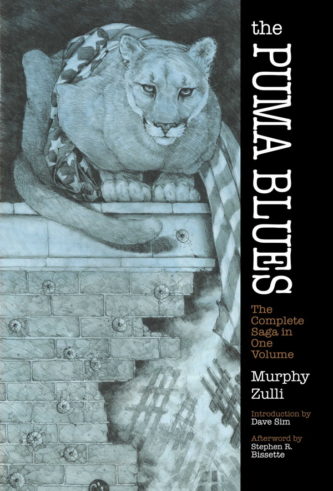 By STEPHEN MURPHY, MICHAEL ZULLI (Dover; 2015)
By STEPHEN MURPHY, MICHAEL ZULLI (Dover; 2015)
This avant-garde comic saga was for much of its existence the most elusive entry in the comic book renaissance of the 1980s. It was hailed by industry luminaries like Alan Moore, Neil Gaiman and Stephen Bissette, who ranked it alongside eighties-era classics of the form like WATCHMEN and MOONSHADOW, yet actually tracking the down THE PUMA BLUES was no easy task. An ongoing series that spanned the years 1986-89, it was initially published in 23 issues, of which I’ve only ever managed to track down a few (THE PUMA BLUES’ turbulent publication history is outlined by Bissette in a lengthy afterword to the present volume). Thus, Dover’s 2015 omnibus edition of THE PUMA BLUES, which comes complete with a newly written conclusion—the comic’s original run was never properly finished—is a thrice-welcome publication.
THE PUMA BLUES is a deeply idiosyncratic, poetic concoction that mixes autobiographical angst, environmental outrage and science fiction into a mighty confounding whole. Fully immersing oneself in its teasingly enigmatic rhythms requires a fair amount of concentration, although Michael Zulli’s gorgeously rendered black and white artwork makes that task a bit easier than it might have been otherwise.
Scripter Stephen Murphy (of the TEENAGE MUTANT NINJA TURTLES comic series) was undergoing some personal issues at the time of PUMA BLUES’ inception, which explains the relentlessly bleak, melancholy tone. The setting is the “future” year 1997, marked by ecological catastrophe due to unchecked pollution and a nuclear bomb detonated by terrorists in the Bronx. A variety of characters are caught up in this depleted environ, including an impeccably drafted puma residing in the wilds of New England along with flying manta rays and a government agent traumatized by the recent death of his father. This guy, a stand-in for Mr. Murphy, is on a vaguely explained mission to measure the level of pollution afflicting the puma’s habitat.
In his introduction Dave Sim, who published THE PUMA BLUES’ initial print run, argues that the environmental scare angle is overstated, and I tend to agree (among the “evidence” cited is a questionable statistic about “over 200 animal species” going extinct “every day”). Murphy and Zulli deserve credit, however, for raising such issues back in the 1980s, long before they became political currency.
More troubling to many readers, I imagine, will be the series’ drift into sci fi conspiracy territory, with the specters of Roswell and Area 51 increasingly dominating the proceedings. The four horsemen of the apocalypse also come into play in this section, which freely utilizes symbolism and surrealism.
Most problematic for me was the lengthy final chapter, drafted 25 years after the series was “completed.” That explains why it has such a wildly different look and feel, and references to recent events like the Occupy movement and the BP Deepwater oil spill that feel out of place amid the eighties-centric bent of the rest of the series. Ultimately I think THE PUMA BLUES ends best where it did back in 1989, which even if it wasn’t the proper conclusion still finishes things off in an enigmatic yet fascinating manner that’s entirely in keeping with the rest of the series.
